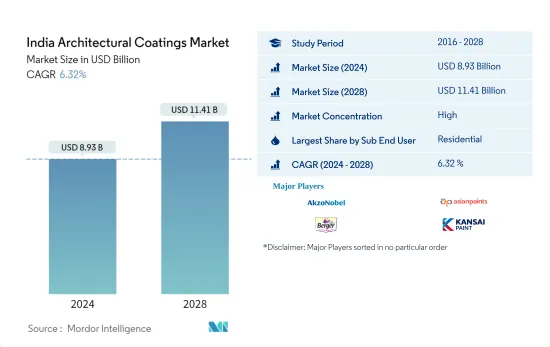 |
市场调查报告书
商品编码
1683769
印度建筑涂料:市场占有率分析、产业趋势与统计、成长预测(2025-2030 年)India Architectural Coatings - Market Share Analysis, Industry Trends & Statistics, Growth Forecasts (2025 - 2030) |
||||||
价格
※ 本网页内容可能与最新版本有所差异。详细情况请与我们联繫。
简介目录
印度建筑涂料市场规模预计在 2024 年为 89.3 亿美元,预计到 2028 年将达到 114.1 亿美元,预测期内(2024-2028 年)的复合年增长率为 6.32%。

主要亮点
- 最大的终端用户细分市场:住宅:受新房屋住宅增加和政府相关建筑的倡议的推动,住宅领域占建筑涂料消费的大部分。
- 按技术领域分類的最大细分市场:水性:由于人们对低VOC水性涂料的认识不断提高,水性涂料估计将是规模最大且成长最快的细分市场。
- 按树脂分類的最大细分市场:丙烯酸:在印度,作为一个对价格敏感的市场,压克力型涂料压克力型涂料由于价格低廉且 VOC 含量低而主导着树脂市场。
印度建筑涂料市场趋势
按终端用户细分,住宅是最大的。
- 由于货币贬值和商品及服务税的实施,印度的建筑涂料消费量在 2016 年和 2017 年有所下降。由于现金供应受到限制,废钞影响了消费者的零售支出。因此,消费者开始优先购买日常必需品而不是住宅油漆。 2017 年 7 月生效的商品及服务税也对油漆业产生了相当大的影响,因为油漆被归类为 28% 的商品及服务税,高于以消费税、增值税(VAT) 和入境税形式缴纳的 24-27%。此外,2017年国内生产总值)与前一年同期比较下降了1.5%。
- 由于占地面积增加和建筑开发领域的外国直接投资(FDI)股权流入增加,消费量在 2018 年迅速復苏并达到顶峰。例如,根据印度工业和国内贸易促进部的数据,2018 年的外国直接投资从 2017 年的 1.05 亿美元增加至 5.4 亿美元。
- 据观察,2019 年建筑涂料的消费量略有增长,而 2020 年则出现下降,原因是该国新冠疫情蔓延以及为期 50 天的全国封锁导致住宅和商业领域的新建设下降。由于该国人口的增长和蓬勃发展的建筑业的积极投资,预计预测期内消费和销售将以显着的速度增长。根据国际货币基金组织预测,2022-26年间印度总人口预计将成长3.6%。
印度建筑涂料产业概况
印度建筑涂料市场适度整合,前五大公司占63.10%的市占率。该市场的主要企业是:阿克苏诺贝尔公司、亚洲涂料公司、伯杰印度涂料公司、关西涂料公司和日本涂料控股公司(按字母顺序排列)。
其他福利
- Excel 格式的市场预测 (ME) 表
- 3 个月的分析师支持
目录
第 1 章执行摘要和主要发现
第 2 章 简介
- 研究假设和市场定义
- 研究范围
- 调查方法
第三章 产业主要趋势
- 占地面积趋势
- 法律规范
- 价值链与通路分析
第 4 章 市场细分
- 次级终端用户
- 商业的
- 住宅
- 科技
- 溶剂型
- 水性
- 树脂
- 丙烯酸纤维
- 醇酸
- 环氧树脂
- 聚酯纤维
- 聚氨酯
- 其他树脂类型
第五章 竞争格局
- 重大策略倡议
- 市场占有率分析
- 业务状况
- 公司简介
- Acro Paints Limited
- AkzoNobel NV
- Asian paints
- Axalta Coating Systems
- Berger Paints India
- Jotun
- JSW
- Kansai Paint Co.,Ltd.
- Nippon Paint Holdings Co., Ltd.
- Shalimar Paints
- Surfa Coats India Private Limited
第六章 执行长的关键策略问题
第七章 附录
- 世界概况
- 概述
- 五力分析框架
- 全球价值链分析
- 市场动态(DRO)
- 资讯来源和进一步阅读
- 图片列表
- 关键见解
- 资料包
- 词彙表
简介目录
Product Code: 93088
The India Architectural Coatings Market size is estimated at USD 8.93 billion in 2024, and is expected to reach USD 11.41 billion by 2028, growing at a CAGR of 6.32% during the forecast period (2024-2028).

Key Highlights
- Largest Segment by End-user - Residential : The residential sector dominated the architectural coating consumption due to the rising construction of new houses and the government initiatives for the building
- Largest Segment by Technology - Waterborne : The waterborne coating is estimated to be the largest and the fastest growing segment due to the rising awareness for the low VOC emission waterborne coatings.
- Largest Segment by Resin - Acrylic : The acrylic coating has dominated the resin market as the country is price sensitive marketplace and the acrylic coatings are cheaper and has low VOC emission.
India Architectural Coatings Market Trends
Residential is the largest segment by Sub End User.
- The architectural coating consumption in India dipped in 2016 and 2017 due to the demonetisation and introduction of GST. The demonetisation impacted the retail spending of the consumers due to limited availability of cash. Thus, diverting the priority of consumers spending on the daily needs rather than painting the houses. The Goods and service tax, which came into effect in July, 2017 also laid a considerable impact on the paint industry as the Paints have been classified in the GST tax rate slab of 28%, higher than 24-27% paid out in the form of excise, value added tax (VAT) and entry taxes. Furthermore, the country's GDP declined by 1.5% in 2017 compared to the previous years.
- The consumption recovered quickly and peaked in 2018 due to the higher addition of floor area and increasing foreign direct investment (FDI) equity inflows for the construction development sector. For instance, According to Department for Promotion of Industry and Internal Trade (India) the FDI in 2018 increased to 540 USD million from 105 USD million in 2017.
- The slow growth in the architectural coating consumption was observed in 2019 followed by a decline in 2020 due to lower new constructions in both residential cand commercial sector owing to the spread of covid-19 in the country and lockdown of 50 days across the country. The increase in consumption and sales is expected to grow at a significant rate in the forecasted period due to the rising population in the country and positive investment in the rapid growing construction sector. According to IMF, The total population in the country is expected to increase by 3.6% during the 2022-26.
India Architectural Coatings Industry Overview
The India Architectural Coatings Market is moderately consolidated, with the top five companies occupying 63.10%. The major players in this market are AkzoNobel N.V., Asian paints, Berger Paints India, Kansai Paint Co.,Ltd. and Nippon Paint Holdings Co., Ltd. (sorted alphabetically).
Additional Benefits:
- The market estimate (ME) sheet in Excel format
- 3 months of analyst support
TABLE OF CONTENTS
1 EXECUTIVE SUMMARY & KEY FINDINGS
2 INTRODUCTION
- 2.1 Study Assumptions & Market Definition
- 2.2 Scope of the Study
- 2.3 Research Methodology
3 KEY INDUSTRY TRENDS
- 3.1 Floor Area Trends
- 3.2 Regulatory Framework
- 3.3 Value Chain & Distribution Channel Analysis
4 MARKET SEGMENTATION
- 4.1 Sub End User
- 4.1.1 Commercial
- 4.1.2 Residential
- 4.2 Technology
- 4.2.1 Solventborne
- 4.2.2 Waterborne
- 4.3 Resin
- 4.3.1 Acrylic
- 4.3.2 Alkyd
- 4.3.3 Epoxy
- 4.3.4 Polyester
- 4.3.5 Polyurethane
- 4.3.6 Other Resin Types
5 COMPETITIVE LANDSCAPE
- 5.1 Key Strategic Moves
- 5.2 Market Share Analysis
- 5.3 Company Landscape
- 5.4 Company Profiles
- 5.4.1 Acro Paints Limited
- 5.4.2 AkzoNobel N.V.
- 5.4.3 Asian paints
- 5.4.4 Axalta Coating Systems
- 5.4.5 Berger Paints India
- 5.4.6 Jotun
- 5.4.7 JSW
- 5.4.8 Kansai Paint Co.,Ltd.
- 5.4.9 Nippon Paint Holdings Co., Ltd.
- 5.4.10 Shalimar Paints
- 5.4.11 Surfa Coats India Private Limited
6 KEY STRATEGIC QUESTIONS FOR ARCHITECTURAL COATINGS CEOS
7 APPENDIX
- 7.1 Global Overview
- 7.1.1 Overview
- 7.1.2 Porter's Five Forces Framework
- 7.1.3 Global Value Chain Analysis
- 7.1.4 Market Dynamics (DROs)
- 7.2 Sources & References
- 7.3 List of Tables & Figures
- 7.4 Primary Insights
- 7.5 Data Pack
- 7.6 Glossary of Terms
02-2729-4219
+886-2-2729-4219









